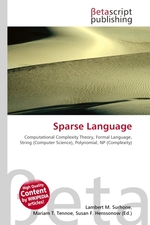Sparse Language
Lambert M. Surhone, Miriam T. Timpledon, Susan F. Marseken
бумажная книга
High Quality Content by WIKIPEDIA articles! In computational complexity theory, a sparse language is a formal language (a set of strings) such that the number of strings of length n in the language is bounded by a polynomial function of n. They are used primarily in the study of the relationship of the complexity class NP with other classes. The complexity class of all sparse languages is called SPARSE. SPARSE contains TALLY, the class of unary languages, since these have at most one string of any one length. Although not all languages in P/poly are sparse, there is a polynomial-time Turing reduction from any language in P/poly to a sparse language. Fortune showed in 1979 that if any sparse language is co-NP-complete, then P = NP; Mahaney used this to show in 1982 that if any sparse language is NP-complete, then P = NP (this is Mahaney's theorem). A simpler proof of this based on left-sets was given by Ogihara and Osamu in 1991. EXPTIME ? NEXPTIME if and only if there exist sparse languages in NP that are not in P. In 1999, Jin-Yi Cai and D. Sivakumar, building on work by Ogihara, showed that if there exists a sparse P-complete problem, then L = P.
Данное издание не является оригинальным. Книга печатается по технологии принт-он-деманд после получения заказа.


